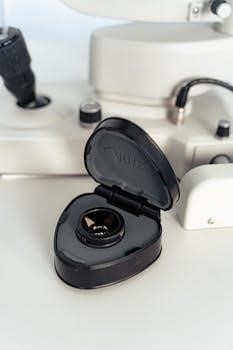Neuroanatomy Through Clinical Cases PDF⁚ An Overview
Neuroanatomy Through Clinical Cases PDF offers an interactive approach to learning. It uses real clinical cases and radiologic images. The book integrates anatomical and clinical knowledge effectively. It is fully updated with the latest advances.
Neuroanatomy through Clinical Cases pioneers an interactive method for teaching neuroanatomy. It connects anatomical details with clinical relevance, enhancing understanding. The book uses actual clinical cases and high-quality radiologic images to bring the subject to life. It is designed to effectively teach neuroanatomy to medical students. It is a valuable resource for building a foundation in neurology for medical students and residents through an effective teaching approach.
The Interactive Approach to Teaching Neuroanatomy
The interactive approach in Neuroanatomy Through Clinical Cases enhances learning through engagement. This method uses case studies to illustrate neuroanatomical concepts, making the subject more relatable. High-quality radiological images help visualize complex structures. The book is designed to promote a deeper understanding of neuroanatomy’s clinical applications. This interactive pedagogy is effective for both medical students and residents. It helps connect theory with real-world scenarios, improving diagnostic skills.
Key Features of “Neuroanatomy Through Clinical Cases”
The book excels with clinical cases and radiologic images. It integrates anatomical and clinical knowledge seamlessly. Its interactive approach enhances understanding. It offers updated content reflecting advances in the field. It includes online access.
Clinical Cases and Radiologic Images
The hallmark of “Neuroanatomy Through Clinical Cases” is its extensive use of real-world clinical scenarios. Over 100 cases bring neuroanatomy to life, illustrating how anatomical knowledge applies directly to patient diagnosis and management. High-quality radiologic images, including CT scans and MRIs, complement these cases, providing visual context and reinforcing the link between anatomical structures and their appearance in clinical imaging, aiding in comprehension.
Integration of Anatomical and Clinical Knowledge
“Neuroanatomy Through Clinical Cases” excels in merging anatomical details with clinical relevance. Each chapter presents neuroanatomical structures and pathways alongside discussions of related clinical disorders. Clinical cases are integrated to demonstrate the practical application of anatomical knowledge in diagnosing and understanding neurological conditions. This approach helps students bridge the gap between basic science and clinical practice, creating a deeper understanding of neuroanatomy.

Content and Structure of the Book
The book covers neuroanatomical structures and pathways. It includes clinical disorders and case studies. Each chapter presents background material. Cases teach localization and differential diagnosis. It employs an interactive approach to learning.
Neuroanatomical Structures and Pathways
The book delves into the detailed exploration of neuroanatomical structures. It meticulously outlines the various neural pathways within the central and peripheral nervous systems. Readers gain a comprehensive understanding of how these structures interconnect. The text provides insights into their functional roles. It covers essential anatomical elements. The book’s content is designed to enhance understanding. It promotes effective learning of neuroanatomy.
Clinical Disorders and Case Studies
The book features extensive clinical disorders related to neuroanatomy. It presents numerous case studies that illustrate real-world applications of anatomical knowledge. Each case study provides detailed patient histories, neurological examination findings, and diagnostic images. The integration of clinical cases enhances understanding of disease processes. It allows readers to apply their knowledge to practical scenarios. This approach improves diagnostic and problem-solving skills in neurology. It is a valuable educational tool.

Availability and Accessing the PDF
The Neuroanatomy Through Clinical Cases PDF is available through various online platforms and digital libraries. Some sources offer free downloads. Others require a subscription or purchase. Always verify the legitimacy of download sources.
Downloading the PDF from Various Sources
The Neuroanatomy Through Clinical Cases PDF can be downloaded from multiple sources, including publisher websites and online repositories. Some academic platforms may offer it for free, while others require a purchase or subscription. Users should exercise caution and ensure they are downloading from legitimate and secure websites to avoid malware or copyright infringement issues. Always check for reviews or ratings before downloading.
Online Libraries and Platforms
Several online libraries and platforms offer access to Neuroanatomy Through Clinical Cases PDF. Z-Library is mentioned as a source for free downloads. Academic platforms like ResearchGate may also host the book or related research. Additionally, platforms associated with medical education often provide access to textbooks. Always verify the legitimacy and copyright status of the PDF before downloading from any online source.

Relevance and Target Audience
Neuroanatomy Through Clinical Cases PDF is highly relevant for medical students. It also targets residents in neurology and neurosurgery. Professionals in these fields benefit too. The book enhances their clinical and anatomical knowledge. It aids in diagnosis.
Medical Students and Residents
Neuroanatomy Through Clinical Cases PDF is an invaluable resource for medical students. It builds a strong foundation in neurology. It integrates anatomical knowledge with clinical applications, enhancing their understanding. Residents in neurology and neurosurgery also greatly benefit. The case-based approach aids in diagnostic skills. They learn to apply neuroanatomy in real-world scenarios, improving their clinical practice. The book is designed to make this complex subject very easy.
Neurology and Neurosurgery Professionals
Neurology and neurosurgery professionals will find “Neuroanatomy Through Clinical Cases PDF” extremely beneficial. The book offers a comprehensive and updated review of neuroanatomy. It aids in refining diagnostic and localization skills through case studies. High-quality radiologic images enhance understanding of complex anatomical relationships. The integration of clinical cases helps bridge the gap between theory and practice. Professionals can use it for continuous learning and to stay updated with the latest advances in the field, and enhance their work.
Updates and Editions
The book is updated with new cases. It contains the latest advances in the field. There is also an interactive eBook subscription. These updates ensure the content is current. They also enhance learning experience.
New Cases and Advances in the Field
The updated editions of “Neuroanatomy Through Clinical Cases” incorporate new clinical cases. These cases reflect the latest advancements in neuroanatomy and related clinical fields. The inclusion of these new cases ensures that students and professionals are exposed to current diagnostic and treatment approaches. Advances in neuroimaging techniques and neurological understanding are also integrated. This keeps the content relevant and up-to-date with modern medical practices.
Interactive eBook Subscription
Many editions of “Neuroanatomy Through Clinical Cases” offer an interactive eBook subscription. This subscription provides digital access to the book’s content. Interactive features enhance the learning experience through multimedia elements. Users benefit from searchable text, interactive diagrams, and integrated clinical cases. The eBook format allows for convenient access on various devices. The subscription often includes updates and additional resources, ensuring comprehensive and current learning material for subscribers.
Book Reviews and Academic Reception
“Neuroanatomy Through Clinical Cases” receives critical acclaim for its interactive approach. Reviews highlight its usefulness in medical education. The book’s integration of clinical cases enhances understanding. It is well-regarded by students and educators.
Critical Acclaim for the Interactive Approach
The interactive approach of “Neuroanatomy Through Clinical Cases” has garnered significant critical acclaim within the medical education community. Reviewers consistently praise the book for its innovative method of integrating clinical cases with neuroanatomical concepts. This approach is considered highly effective in enhancing student engagement and facilitating a deeper understanding of the subject matter. The use of real-world scenarios is particularly valued for its ability to bridge the gap between theoretical knowledge and practical application, making learning more relevant and memorable.
Usefulness for Medical Education
“Neuroanatomy Through Clinical Cases” is widely recognized for its usefulness in medical education. The book provides a solid foundation in neuroanatomy, crucial for medical students and residents. Its case-based approach enhances learning by linking anatomical knowledge to clinical applications. The integration of radiologic images and case studies aids in understanding localization and differential diagnosis. This interactive method is effective for both neurology and neurosurgery professionals, fostering a deeper comprehension of neurological disorders and patient care.
Specific Topics Covered in the Book
The book covers localization and differential diagnosis extensively. Neurologic examination and case presentations are detailed. It integrates anatomical knowledge with clinical scenarios. It is helpful for understanding neurologic disorders and patient care.
Localization and Differential Diagnosis
The book emphasizes localization skills, crucial for identifying the site of neurological lesions. It presents varied clinical cases that require students to pinpoint affected neuroanatomical structures. Differential diagnosis is thoroughly addressed, guiding readers through the process of distinguishing between conditions with similar presentations. This approach enhances diagnostic reasoning and clinical problem-solving abilities. Through case studies, readers learn to correlate symptoms with specific anatomical regions.
Neurologic Examination and Case Presentations
The book intricately links neuroanatomy to the neurologic examination, demonstrating how anatomical knowledge informs clinical assessment. Each case presentation includes a detailed neurologic exam, guiding students through key steps. This practical approach emphasizes the correlation between exam findings and underlying neuroanatomical structures. The case presentations effectively illustrate how to perform and interpret neurologic exams. Students gain a solid foundation in relating clinical signs to specific neuroanatomical pathways, improving diagnostic accuracy.
Benefits of Using Clinical Cases in Neuroanatomy
Clinical cases enhance understanding and retention of complex neuroanatomical concepts. They allow the application of knowledge to real-world scenarios. This approach bridges the gap between theory and practice, making learning more engaging and effective.
Enhanced Understanding and Retention
Using clinical cases significantly enhances understanding and retention of neuroanatomy. Traditional rote memorization can be challenging, but real-life cases provide context. By applying anatomical knowledge to diagnostic scenarios, students develop a deeper grasp of the material. This active learning approach transforms abstract concepts into practical, memorable insights, improving long-term retention and comprehension of neuroanatomical principles through problem-solving.
Application of Knowledge to Real-World Scenarios
Clinical cases facilitate the application of neuroanatomy knowledge to real-world scenarios. Students learn to correlate anatomical structures with clinical manifestations of neurological disorders. This practical approach develops critical thinking skills necessary for accurate diagnoses and treatment plans. By analyzing patient histories, neurological exams, and radiologic images, learners bridge the gap between textbook knowledge and clinical practice, preparing them for effective problem-solving in medical settings.

Additional Resources and Support
Neuroanatomy Through Clinical Cases PDF often includes links, nursing organizations, and health news. These resources provide further learning. They also offer support for advanced practice. Such materials enhance understanding and keep professionals updated.
Weblinks and Advanced Practice Nursing Organizations
For those studying Neuroanatomy Through Clinical Cases PDF, various weblinks provide essential supplementary materials. These links often connect to academic articles, interactive tools, and detailed anatomical diagrams. Advanced Practice Nursing Organizations also offer support through continuing education, professional development, and networking opportunities. Accessing these resources can significantly enhance understanding and practical application of neuroanatomical concepts, aiding both students and practicing professionals in the field.
Current Health News RSS Feeds and Books
Staying updated with current health news through RSS feeds is crucial for neuroanatomy students and professionals. These feeds deliver the latest research, clinical findings, and advancements in neurology and related fields, complementing the knowledge gained from Neuroanatomy Through Clinical Cases PDF. Complementary books offer deeper dives into specialized topics, expanding understanding beyond the textbook. Combining these resources ensures a well-rounded and current perspective on neuroanatomy and its clinical applications.
